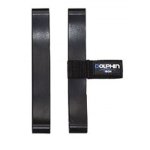Shop by Category
Info
- This product is also found in:
- Valves / Manifolds
- Rebreather Cylinders and Valves
- Reels and Emergency
The Sonar Premium Rebreather In-Line 230 Bar Valve is an inline configuration popular with rebreather divers for use on their cylinders.
The valves have five-thread 200 bar DIN (G 5/8 BSP) outlets. Inlets have standard 3/4-14 NPSM neck threads for use with all modern Australian standard aluminium and steel scuba tanks and include a threaded 'dip tube' with hex opening for easy installation.
These valves are suitable for use with most 200 to 232 bar steel and aluminium cylinders supplied in Australia, e.g. Faber, Catalina, Luxfer etc. They are strong and reliable and are made from really top quality materials. Valves have a 0.3 mm burst disk.
WARNING: Please ensure that you are fitting the valve to the correct cylinder. If in doubt please ask.
The Sonar Premium Inline Valves include a nearly indestructible handwheel made from soft rubber formed around a stainless steel insert. The stainless steel insert ensures positive operation with a long-lasting life. The large ribs make it easy to open or close the valve even while wearing gloves. The rubber with stainless steel insert handwheel design is the preferred choice of technical divers. The black handwheel is standard. Optional green colour handwheels are available.
Sonar Premium Rebreather In-Line Valve 225 bar Features
- Perfect design for most rebreathers
- Standard 3/4-14 NPSM neck threads
- Suitable for either 207 bar (3000 psi) or 232 bar (3442 psi) cylinders
- Nitrox Ready 40% - Chromed Brass Construction
- Valves have a 0.3 mm burst disk
Valve Oxygen Cleaning:
This valve is Nitrox ready up to 40%. If you are planning to use this valve on a cylinder with Enriched Air Nitrox (Nitrox) mixes from more than 40% up to 100% oxygen, it's essential for the safety of the cylinder user, and the person filling the cylinder, that the valve be oxygen cleaned and prepared with special o-rings, seats, and grease designed for exposure to pure oxygen. The cylinder should then be banded with the familiar yellow and green Nitrox band/wrap/sticker, and an Oxygen Clean 'In Test' inspection sticker applied.
What is the difference between DIN "200 Bar " and DIN "300 Bar " valves?
The Deutsches Institut Für Normung (DIN) is a German standards-setting organization similar to our American National Standards Institute (ANSI) and Compressed Gas Association (CGA). DIN 477 is a specification that recommends cylinder valve outlet and connector designs for specific types of gases and pressures based upon safety considerations. These various designs have deliberate incompatibilities to preclude the possibility of errors when handling different types of compressed gases at differing working pressures.
The two valve outlets and connectors of interest for divers are the DIN 477 No. 13 and the DIN 477 No. 56 (formerly No. 50), both designated for use with compressed air. The DIN 477 valve and regulator fittings are most widely used outside the U.S. The regulator first stage DIN connector is a male screw type, and instead of clamping onto the outside of the valve as does the yoke, it screws directly into the female DIN outlet of the valve. The sealing O-ring is held at the end of the regulator connector rather than in the face of the outlet. The DIN 477 system, with its captured o-ring design, has proven to be very reliable for use with SCUBA.
Outlet/Connector #13 is from DIN 477 part 1 - for cylinders with test pressure ratings up to 300 bar and is commonly referred to in the SCUBA industry by the slang term "200 bar", probably because most cylinders with 300 bar test pressures have working pressures in the 200 bar range.
Outlet/Connector #56 is from DIN 477 part 5 - for cylinders with test pressure ratings up to 450 bar and is commonly referred to in the SCUBA industry by the slang term "300 bar". The two designs are nearly identical, but the #56 valve outlet is deliberately deeper so the shorter #13 connector will not be long enough to seat properly. This is a safety feature to prevent connecting a low-pressure device to a high-pressure supply.
It's important to understand that the "200 bar " or "300 bar " descriptions are just slang terms that have nothing to do with the pressure ratings of the outlets and connectors themselves!.
(12/22 HS)












